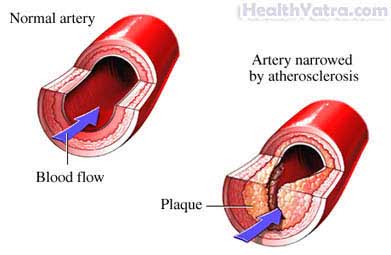Definition
Peripheral vascular disease (PVD) is disease of any blood vessel that is not part of the heart or brain. Peripheral artery disease (PAD) is caused by deposits of fatty material called atheroma in arteries of the legs. Since arteries carry oxygen-rich blood to the cells of the body, a reduction in blood flow can cause bodily organs to fail.
This is a serious condition that requires care from your doctor. The sooner PAD is treated, the better the outcome. If you suspect you have this condition, contact your doctor.
Causes
PAD is usually caused by a gradual buildup of plaque called atherosclerosis that happens within the arteries. Other causes include blood clots or embolisms, congenital heart disease, and inflammation of the blood vessels called vasculitis.

PAD can be hereditary. You also may get PAD if you are overweight or obese, or havehigh blood pressure, diabetes, or high cholesterol. Unhealthy lifestyle choices such as smoking, eating a high-fat diet, and not getting enough exercise lead to PAD.
Risk Factors
Factors that increase your chance of developing PAD include:
- Diabetes
- Cigarette smoking
- High blood pressure or family history of high blood pressure
- Strokeor family history of stroke
- High cholesterol or family history of high cholesterol
- Age: Over 50
- High homocysteine level in blood
- Gender: Male
- Family history of PAD
Symptoms
Symptoms of PAD are related to the organ or part of the body deprived of blood. This includes:
- Pain, fatigue, aching, tightness, weakness, cramping or tingling in the leg(s) brought on by exercise that goes away when resting
- Numbness and pain of the legs or feet at rest
- Cold hands, legs, or feet
- Loss of hair on the legs and/or feet
- Paleness or blueness of the legs
- Weak or absent pulse in the leg
- Sores, ulcer, or infection of the feet and legs that heal slowly
- Erectile dysfunction
- Swelling in lower extremities
- Muscle atrophy
Diagnosis
Your doctor will ask about your symptoms and medical history. A physical exam will be done.
During the exam, your doctor may:
- Check the strength of the pulse in the leg arteries
- Listen for a whooshing sound in a leg artery or the abdomen using a stethoscope
- Check blood pressure at various points in the leg and compare it to the normal arm blood pressure
- Conduct a treadmill test
Your bodily fluids may be tested. This can be done with blood tests.
Images may need to be taken of your internal bodily structures. This can be done with:
- Ultrasound and doppler analysis
- Angiography
- Magnetic resonance imaging (MRI)
Your heart activity may need to be tested. This can be done with electrocardiogram (ECG, EKG).
Treatment
Early treatment can slow or stop the disease. Talk with your doctor about the best treatment plan for you. Treatment options include the following:
Lifestyle Changes
- Smoking cessation
- Diabetes control
- Blood pressure control
- Increased physical activity—such as a walking program
- Weight loss, if overweight
- Low-saturated fat, low-cholesterol diet
- Foot care —very important for people with diabetes:
- Shoes that fit properly
- Proper treatment of all foot injuries—healing is slowed when circulation is poor, so the risk of infection is higher
Medication
Your doctor may prescribe:
- Blood thinners
- Pain medication
- Cholesterol-lowering agents called statins
- Medicines to enlarge or dilate the affected arteries
Invasive Procedures
Procedures may include:
- Balloon angioplasty—a balloon is inflated in the artery to stretch it
- Stent implant—a wire mesh tube is placed in the artery; the stent expands and stays in place, keeping the artery open
- Laser treatment
- Atherectomy—a tube called a catheter is used to remove plaque inside a blood vessel
Surgery
Surgery to open up narrowed arteries is performed in severe cases.
- Endarterectomy—the lining of the artery is removed, along with plaque build up
- Bypass surgery—a vein from another part of the body or a synthetic graft replaces the vessel
If you are diagnosed with PAD, follow your doctor’s instructions.
Prevention
To help reduce your chances of getting PAD, make the lifestyle changes listed above under treatment.
